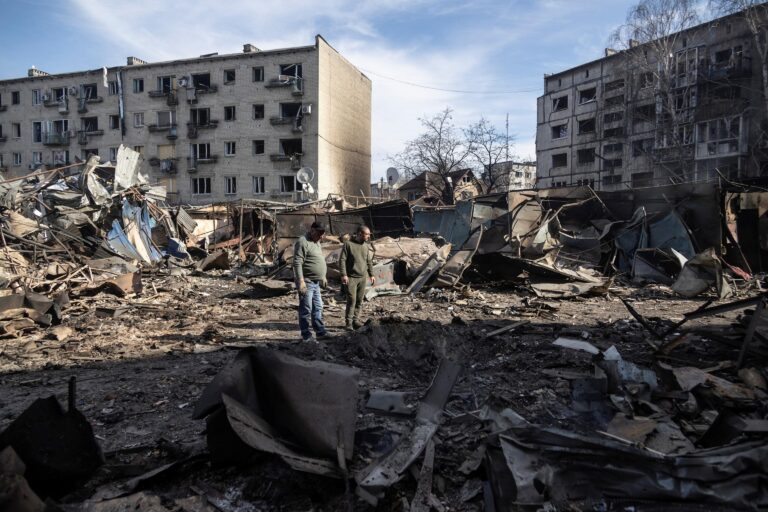In the evolving conflict between Russia and Ukraine, the use of drone technology has emerged as a pivotal factor shaping the battlefield dynamics. Russia’s strategic deployment of drones has not only altered the pace and precision of attacks but also introduced new complexities for Ukrainian defense forces. This illustrated guide by CNN examines how these unmanned systems have redefined warfare in Ukraine, highlighting key incidents, technological advancements, and the broader implications for modern combat. Through detailed visuals and expert analysis, the article offers an in-depth look at the transformative role of drone strikes in one of today’s most closely watched conflicts.
The Tactical Evolution of Drone Warfare in Ukraine’s Conflict
Russia’s employment of drones has fundamentally altered battlefield dynamics in Ukraine, introducing new layers of tactical complexity. Small, cost-effective unmanned aerial vehicles (UAVs) have become force multipliers, enabling real-time reconnaissance, precision targeting, and electronic warfare capabilities. This shift has allowed Russian forces to conduct raids with unprecedented speed and accuracy, undermining traditional defense structures. The integration of swarm tactics-where multiple drones are deployed simultaneously to overwhelm air defenses-has further exposed vulnerabilities in Ukrainian military response systems, forcing rapid adaptation on the frontlines.
Several distinct operational roles have emerged under this new drone warfare paradigm, including:
- Surveillance and Target Acquisition: Persistent aerial monitoring to detect troop movements and logistic hubs.
- Kamikaze Drone Strikes: Use of drones loaded with explosives to neutralize high-value targets more effectively than conventional artillery.
- Signal Jamming and Electronic Countermeasures: Disrupting Ukrainian communications networks to sow confusion and delay counterattacks.
| Drone Type | Role | Range (km) | Payload |
|---|---|---|---|
| Orlan-10 | Reconnaissance | 120 | Optical Sensors |
| KUB-BLA | Kamikaze Strike | 40 | Explosives |
| Forpost | Surveillance & Jamming | 250 | Electronic Warfare Modules |
Key Targets and Impact of Russian Drone Strikes on Ukrainian Defenses
Russian drone strikes have strategically targeted critical nodes within Ukrainian defensive infrastructure, aiming to weaken command-and-control capabilities while disrupting supply chains. Key targets include radar installations, ammunition depots, communication towers, and frontline artillery positions. By focusing on these assets, Russia has sought to create operational blind spots and delays, limiting Ukraine’s ability to coordinate rapid counterattacks or reinforce threatened sectors. The precision and low-profile nature of these UAVs have enabled strikes deep behind Ukraine’s frontlines, compounding challenges for defense planners.
- Radar and surveillance systems: Disabling early warning networks to reduce air defense efficacy.
- Logistics hubs: Targeting supply depots to disrupt fuel and ammunition flow.
- Communication nodes: Severing battlefield communications to induce confusion and delay responses.
- Artillery batteries: Hitting frontline weapons to limit fire support capabilities.
| Target Type | Estimated Impact | Frequency of Strikes |
|---|---|---|
| Radar Stations | Reduced early warning times by up to 40% | High |
| Ammunition Depots | Supply delays causing front-line shortages | Medium |
| Communication Towers | Disrupted command coordination for hours | High |
| Artillery Positions | Lowered artillery fire accuracy and volume | Medium |
Beyond direct physical damage, the psychological toll of incessant drone threats has led Ukrainian forces to adopt more cautious deployment patterns and divert resources towards enhanced drone detection and countermeasures. This operational strain has slowed the tempo of Ukrainian offensives and compelled reallocation of critical assets to defense against low-cost drone incursions. As drone technology evolves, the continued pressure on Ukraine’s defenses underscores a new dimension of modern warfare where unmanned systems can decisively influence battlefield dynamics without traditional large-scale engagements.
How Ukraine is Adapting its Countermeasures to Russia’s Drone Offensive
In response to the escalating drone onslaught, Ukrainian forces have rapidly innovated their defensive strategies by integrating advanced electronic warfare (EW) systems and adaptive counter-drone tactics. These EW units disrupt enemy drone navigation and communication, forcing Russian UAVs to lose control or crash. Alongside technological measures, Ukraine has increased the deployment of mobile air defense units capable of quickly relocating to intercept incoming drones. This dynamic approach not only enhances survivability but also complicates Russian operational planning, as drones face more unpredictable and hostile skies.
Key adaptations implemented by Ukrainian forces include:
- Use of signal jamming devices to block drone GPS and control frequencies
- Integration of AI-powered radar systems for faster drone detection and targeting
- Deployment of rapid-response sniper teams trained specifically to shoot down low-altitude drones
- Collaboration with civilians using apps to report UAV sightings in real time
| Countermeasure | Effectiveness | Deployment Speed |
|---|---|---|
| Electronic Warfare Jamming | High | Immediate |
| AI-Powered Drone Detection | Moderate to High | Rapid |
| Mobile Air Defense Units | High | Variable |
| Citizen Reporting Apps | Moderate | Ongoing |
Concluding Remarks
As Russia’s drone attacks continue to evolve, their impact on the battlefield in Ukraine signals a significant shift in modern warfare. From disrupting supply lines to targeting critical infrastructure, these unmanned aerial assaults have added a new dimension to the conflict, challenging traditional defenses and prompting rapid adaptation on both sides. As the war progresses, analysts and military experts will be closely watching how drone technology shapes the future of combat – and what that means for conflict zones worldwide. For now, the unfolding drone campaign remains a stark illustration of how innovation can redefine warfare in real time.




